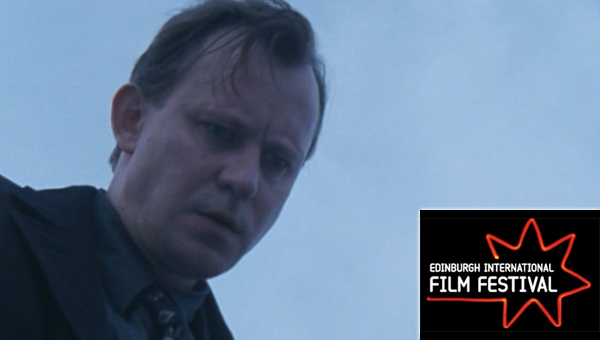httpvh://youtu.be/ZuiqqRtXTz0
Summer solstice is, depending on which way you look at it, the beginning, middle or end of the season. As the days grow gradually shorter after the sun reaches its point of maximum elevation in the sky, our ancestors saw it as the beginning of the end of summer.
That the summer is almost already over will come as no surprise to the citizens of Edinburgh. It seems you just have to whisper the word ‘festival’ and a filmy layer of rain and mist forces tourists to don luminescent prophylactic ponchos and returns the city’s streets to an atmosphere redolent of Stevenson’s Jekyll and Hyde or the novels of Tartan Noir.
… over the rooftops of Edinburgh the sky appeared to have been airbrushed from the scene …
The Midnight Sun reception which preceded the screening of Erik Skjoldbjærg’s INSOMNIA(1997) drew connections between Nordic and Tartan Noir crime fiction, via contributions from the Scandinavian sounding, but assuredly Scottish crime writer, Lin Anderson.
The sun, on the night where she lingers longer than usual, had contracted stage fright and had not made an appearance. Instead, over the rooftops of Edinburgh the sky appeared to have been airbrushed from the scene, replaced by a deathly uniform cloth grey and an occasional sea mist, which throttled the dank black rock of the Castle. The two friends who had accompanied me, both Eastern Europeans, lamented the scene. ‘The sun has died,’ uttered one. ‘Edinburgh has black blood,’ intoned the other.
We’d arrived late, halfway through Lin Anderson’s spoiler-ridden, but admirable and intelligent introduction to the film. The bar staff seemed terrified of making a sound that might interrupt her flow: A cocktail? She would not be happy with the noise made by the shaker. Soda Water? Too fizzy. My friend was suffering terribly from hunger and was overjoyed to find food in the gift bags presented to guests upon their entry, but alas – Swedish crisp bread. She was far too afraid to risk the disturbance that eating them would make.
Engström is a detective who has dubious morality and method, but is respected for getting the job done.
INSOMNIA, directed by Erik Skjoldbjærg and featuring the excellent and distinguished (until committing the atrocity that was MAMMA MIA) Stellan Skarsgård, it could be argued, is a precursor to the Nordic crime series increasing in popularity amongst middle class iPlayer viewers in recent years – all washed out colour palettes, characters of questionable morality (or human – depending on your point of view) and bleak, no-win conclusions.
The origins of Nordic noir, like similar occurrences of the noir genre in Italy, can be attributed to the incidences of collaboration with the Nazis during WWII and the complex relationship with national identity that resulted. A fascination with the past and a need to understand motives and morality often manifests itself in the figure of the detective in crime noir.
INSOMNIA begins in an airplane above the clouds – where the sun seems to set eternally – and the film subtly plays with traditional notions of hell and heaven. Here, north of the Arctic Circle in the ‘land of the Midnight Sun’ Engström (Skarsgård), a Swedish detective, has been called to Norway to assist in a murder case. The audience has already witnessed the crime in scratchy, jerky 16mm in the film’s opening scenes.
Niflheim, an Old Norse version of hell, is a world shrouded in mist, which the dead and dishonourable inhabit together.
Engström is a detective who has dubious morality and method, but is respected for getting the job done. After an attempt to lure the killer into a trap goes wrong, Engström pursues him and makes a critical error, which he tries to cover up and about which only he and the killer know the truth. The pursuit took them sub terrania into a sunless secret tunnel – one of the few dark places in the film – to emerge transformed and foggy in morality into a thick sea mist.
Niflheim, an Old Norse version of hell, is a world shrouded in mist, which the dead and dishonourable inhabit together. In committing his error, Engström has entered this world, a world in which the killer also abides.
These two aside, the other main protagonist in the film is the sun. It is ever present. It simply never sets. There is no rest. When Engström tries to block it out via makeshift blackout screens taped to the window, it malevolently forces its way back in. It will not let him sleep. It suffocates the world in washed-out hospital colours, woozy, uneasy and sick.
In Skjoldbjærg’s original, Engström’s sleeplessness is symptomatic of something more complex.
In Christopher Nolan’s admirable, but inferior remake, the impression was that the detective could not rest until he made amends for his mistake by solving the crime. In Skjoldbjærg’s original, Engström’s sleeplessness is symptomatic of something more complex. His guilt must be absolved, but he must also keep the killer alive for his own purposes. He is fascinated by him. They are similar. They are both rare creatures. They have both killed. They have both constructed a reality for themselves. They are both trying to hide themselves. They are both haunted by the dead.
Skjoldbjærg charts Engström’s fragile state of mind through twitchy, irregular editing, repeated actions and patterns in the scenery, and through subtle sound design. The camerawork mimics opening and closing movements, like eyelids shutting or curtains being pulled and drawn. The result is nauseating and compelling – like a caffeine jolt after no sleep.
At the film’s conclusion Engström’s identity becomes slowly fused with the killer’s. He defends his actions as if they were his own – they are his own, it seems. And, as he leaves the land of the Midnight Sun, he is plunged further into a world of his own darkness.
Outside, despite the solstice, Edinburgh also moves under a blackening winter sky.




